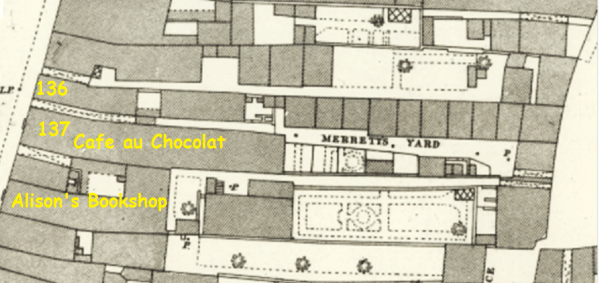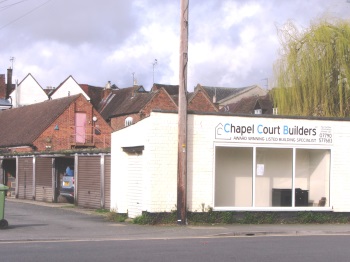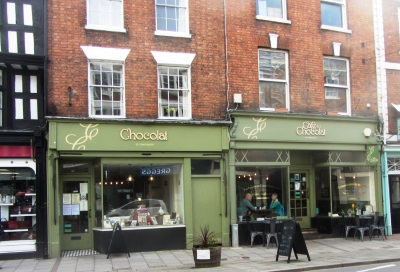Merretts Yard
to Expand
In 1910, a large block of property stretching from the High Street to the Oldbury was auctioned. Lot 1 was a commodious house and shop, a milliner’s, let to the Misses Frost. There were two semi-detached cottages fronting Oldbury Road and six tenements, each containing a kitchen, pantry, coal-room and two bed chambers. This was Merrett’s Yard. It was described by alley historian John Rogers as a fine open court with a lot of good cottages in it let to working men.
The yard was an alley by another name, but with some differences. It occupied the space behind 136 and 137 High Street, now Café au Chocolat, so was twice the width of other alleys. 137 was the ‘front house’, though the alley entrance passed through 136, behind which the tenements were built in a neat row, with the alley passing their doors. Each had a little garden on the opposite side. There was a dispute over Mrs Collins’ garden in 1875, when Amos Webb enclosed it, claiming ownership under the ancient, and peculiarly local, right of ‘Keyholt’. His claim seems to have failed.
Apart from the condition of the buildings, this must have been a spacious and pleasant alley. In 1878, it came under the gaze of the Borough Surveyor, who ordered the erection of a toilet, for which land was very quickly provided. There were none of the usual problems with water supply. In 1906 work was done to the drains and the alley was paved by Collins and Godfrey.

In a crowded community sharing facilities in an age before the welfare state there are always tragedies and tensions, and Merrett’s Yard had its share. In 1869, Henry Weaver, who was once clerk to Walton Cardiff Parish Council was found dead in a disused workshop he habitually slept in. He’d died of hunger, but it was just taken as a fact of life. Even from here, children were attracted to the Swilgate and drowned. Four year old Alec Collins drowned in 1904 and nearly thirty years later Samuel Hallings lifted the body of six year old Thomas Gibbs from the same river.
Petty crime was ruthlessly stamped on. The notorious Susan Evans, described as ‘the worst woman in Tewkesbury’ was jailed for a month for peddling without a licence. Eleven years old Florence Loveridge was remanded in custody for stealing a pair of boots from the Hop Pole. Abusive language cost Frank Woodward four shillings, and Thomas Hodges half a crown.
Disputes between families sometimes flared up into brawls. A dispute between Ellen Stephens and Mary Bullock over a hoe led to Mrs Stephens spending seven days in Gloucester jail. Annie Collins was fined a shilling for giving Annie Hodges a black eye. Annie King had the same penalty for hitting Selina Hodges.

When the chips were down, though, the yard answered the call. All six of the Heath’s sons joined up in the first war, alongside most of the other eligible men. George was wounded, Thomas was gassed. Gunner William Green, 20, was killed in action in 1918.
After the war, the Council turned its attention to housing in the town, and started a long rehousing programme in the Oldbury and Prior’s Park.
The end came slowly for Merrett’s Yard. In 1936 a clearance order was recommended, with the suggestion that tenants could be relocated to new houses being built in Swilgate Road. The process was slow and bureaucratic, though. The Council refused to buy the site once cleared, and there was little incentive for landlords to co-operate. At the end of 1937 a notice of intent to impose a clearance order for eleven houses, four toilets and three wash houses was published. In 1939, owners were requested to clear the site but it wasn’t until May 1943 that the whole of the plot was offered for sale in two lots; 137 High Street, leased to Boots the Chemist, and a cleared site behind, stretching to Oldbury Road.
The cleared site was eventually developed as a row of garages, with a small building fronting Oldbury Road, occupying the footprint of one of the two cottages which once stood there. This is now occupied by Chapel Court Builders. It isn’t, unfortunately, a shining example of town centre regeneration, but the layout of the homes that once stood there can easily be imagined.



Comments